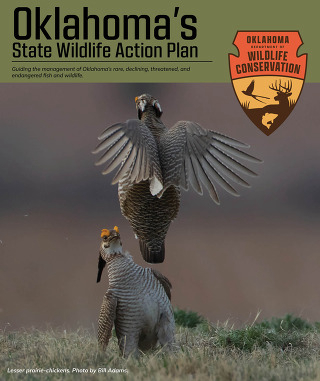
|
Ever wonder how the Wildlife Department decides which nongame wildlife conservation efforts should be undertaken? Many of those decisions boil down to what is reflected in a living document known as Oklahoma’s State Wildlife Action Plan.
This habitat-based document guides how ODWC manages rare, declining, threatened, and endangered species, and is required for ODWC’s continued eligibility for funding from the federal State Wildlife Grants Program. States must update their plans every 10 years, and the staff of ODWC’s Wildlife Diversity Program are drafting Oklahoma’s plan for 2025.
“We would love to have the public’s help in shaping the state’s plan,” said Mark Howery, a senior wildlife biologist for the Wildlife Department. “This plan may be a required document for the Wildlife Department, but it is not regulatory in nature. Instead, it is a guiding and educational document that gives us the opportunity to share which species are declining in the state and what could be done to improve their status.”
Click to View Oklahoma’s Draft Plan
The draft plan identifies 397 fish and wildlife as Species of Greatest Conservation Need. Some of these SGCN are well-known by the public: Texas horned lizard, lesser prairie-chicken, alligator gar, and three-toed box turtle. But most of Oklahoma’s SGCN are low-profile and perhaps naturally rare in the state and infrequently encountered by people.
In addition to identifying the state’s SGCN, the plan outlines conservation issues, actions, and monitoring plans for eight sets of habitats that are important to Oklahoma’s wildlife. If Oklahoma’s plan is approved by the U.S. Fish and Wildlife Service review team, ODWC will maintain its eligibility to receive federal matching funds to support projects designed to benefit Oklahoma’s SGCN. In previous years, ODWC has received about $850,000 each year to conduct status assessments, habitat improvements, and ecological research for SGCN.
Highlights from the Updated Draft Plan
Biologists assessed approximately 750 Oklahoma species when updating the draft plan and identified 136 fish and wildlife species that meet the selection criteria for the 2025 plan but were not included as SGCN in the state’s prior Comprehensive Wildlife Conservation Strategy.
“Many of these species were identified because of relatively recent population declines,” Howery said. “A lot of the bats and shorebirds identified as SGCN in the draft 2025 plan have had long, steady declines that have reached a point of concern in the past 10 years.”
More than two-thirds of the newly designated SGCN are invertebrates.
“Our general understanding of insects and other invertebrates has improved since the last plan revision, especially with better engagement with the entomologist community. Oklahoma has had a number of newly documented insect species, and a number of regionally endemic species have been brought to our attention.
“However, we have limited information for a lot of these species as so few biologists may study the species and so few naturalists recognize and document their occurrences.”
To address species with limited life history information or other ecological data, the Wildlife Department and other states have adopted a category of “Species of Greatest Information Need.”
“This category acknowledges the species may be in trouble, but our understanding is so limited that biologists can’t point to population sizes or trends. There are more questions than answers for these species.”
Of the SGCN included in Oklahoma’s current plan, 51 species no longer meet the state’s selection criteria.
“Many of these can be considered success stories,” Howery said. “Species like the bald eagle have an increasing population trend and are scheduled to be removed from the Oklahoma SGCN list. And survey work in the past 10 years has shown other species like the painted bunting and Cassin’s sparrow have a larger population than previously thought.
“Still other species that are scheduled to be removed from our plan have been reclassified and found to be the same as more widespread species.”
How to Comment
Comments to Oklahoma’s draft State Wildlife Action Plan can be shared with Mark Howery or Kurt Kuklinski, a research supervisor with the Wildlife Department, by Sept. 3, 2025. For specific edits, please indicate the page number or other applicable references.
A finalized plan will be sent the U.S. Fish and Wildlife Service for a comprehensive review by Sept. 30, 2025.